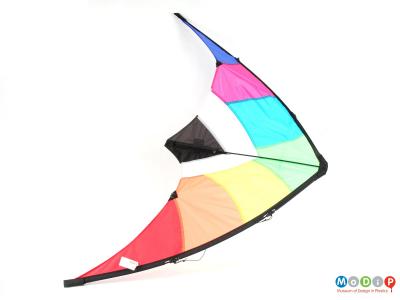Developments in plastic have made sports kites durable and lightweight. Early kites originated from the Far East and were made from delicate natural materials such as wood, bamboo, silk, paper and leaves. It is thought that the first kite was flown in China in around 1000 BC. Historically kites have had many uses, including being symbols of superstition and religion, objects of war, for target training and in observation, as tools for fishing and hunting, as well as being fighting kites, military banners and scientific instruments. Today kites are mainly used for sports both on land and on water.
This is a delta shaped Stunt or Sport Kite (1) and is used to perform stunts in the sky, sometimes to music, either individually or as a team of two or more competitors. It has fibreglass rods, known as spars, to give the kite rigidity and a Spinnaker nylon wing or sail, which is a 'rip-stop' nylon; the grid formation woven into the material stops a tear or rip from expanding beyond the small square. It is the same type of fabric used for the high speed Spinnaker sail of a yacht. This combination of materials, fibreglass and rip-stop nylon, creates a strong almost indestructible structure.
Other sporting kites have a parafoil sail, which looks similar to a parachute. These kites are used to capture the power of the wind to propel the sportsperson in a land buggy or on a land board or surf board. These high speed, high power sports can be fast, spectacular and often dangerous, and come under the 'Extreme Sports' umbrella. The power of the wind is converted into speed or lift to perform dramatic stunts to gain competition points.
Most kites of this type have no rigid structure to hold their shape and rely heavily on the wind not only to power them along, but to maintain their shape and keep them up in the air. If the wind stops blowing the sail can collapse causing the kite to fall out of the sky. To prevent this collapse some parafoil kites have inflatable ribs that are pumped up on the ground giving them a semi-solid structure, whilst others will have fibreglass or carbon fibre ribs to achieve the same results.
Plastic materials have made kites stronger, more robust, and water resistant enabling sportspeople to become more daring and experimental combining kiting with other sports to make them faster and more exciting.

